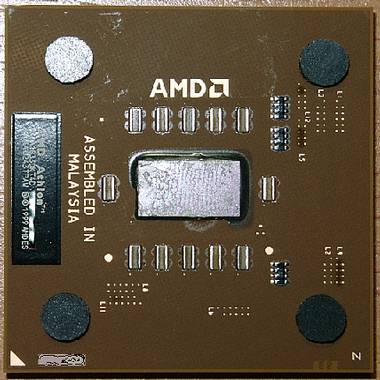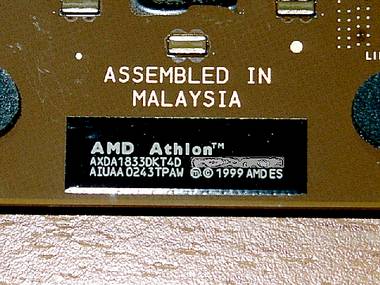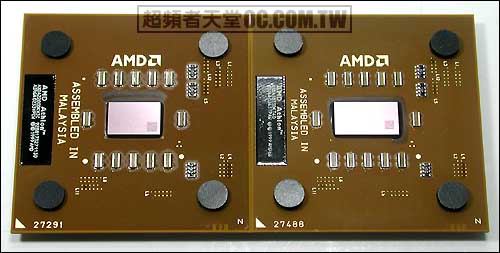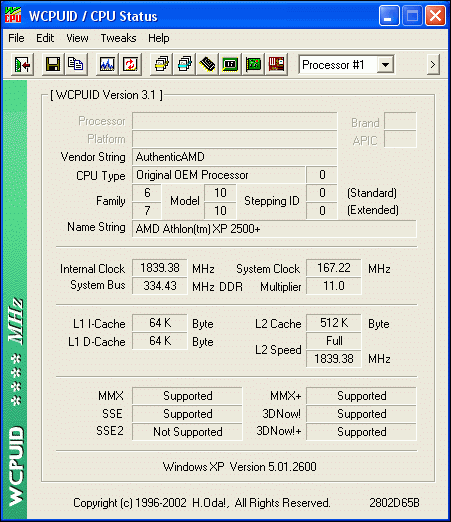AMD Barton 2500+: the first test results
With the help of our good friend cho from GZeasy ( cho!) it turned out that OC.com.tw, having somehow obtained the sample of Barton-based Athlon XP, supporting 166MHz FSB and 512Kb L2 cache — AMD Barton 2500+, posted its test results. And we are posting excerpts from them below. cho!) it turned out that OC.com.tw, having somehow obtained the sample of Barton-based Athlon XP, supporting 166MHz FSB and 512Kb L2 cache — AMD Barton 2500+, posted its test results. And we are posting excerpts from them below.


First, about the CPU itself. The first photos were introduced on November 25 (see The photo of AMD Barton).
What the marking means — AXDA1833DKT4D. Athlon XP (AXD), A – desktop, 1833 MHz (how much is it in QuantiSpeed?), D — OPGA, K – 1.65V core voltage, Ò — +90°C temeprature limit, 4 – 512Kb L2 cache, D – 333MHz FSB. So, it’s actually AMD Barton with 512Kb L2 cache and 333MHz FSB. The larger crystal is illustrated on the following photos of Palomino, Thoroughbred B and Barton, and the more detailed Thoroughbred B and Barton:


Where did they get 2500+ from? First, it’s how WCPUID 3.10 determined, second, it’s how BIOS determined (166 x 11.0):


Barton Cache Info:

Well, all the interesting discussion of Thoroughbred B and Barton, QuantiSpeed, along with conclusions are too much for the news format. Here are just tables for Thoroughbred B and Barton along with the rating forecasts:
| Model | 2000+ | 2100+ | 2200+ | 2400+ |
2600+ | | Clock, MHz | 1667 | 1733 | 1800
| 2000
| 2133
| |
FSB, MHz
| 266
| 266
| 266
| 266
| 266
| |
Bus clock |
133
| 133
| 133
| 133
| 133
| |
Multiplier
| 12.5
| 13.0
| 13.5
| 15.0
| 16.0
|
|
|
2400+
| 2500+ |
2600+
| 2700+ |
2800+
| 3000+
| | Clock, MHz
| 2000
| 1833
| 2083
| 2167
| 2250
| 2333
| |
FSB, MHz
| 333
| 333
| 333
| 333
| 333
| 333
| | Base clock
| 166
| 166
| 166
| 166
| 166
| 166
| |
Multiplier
| 12.0
| 11.0
| 12.5
| 13.0
| 13.5
| 14.0
| | Core
| Tbd-B
| Barton
| Tbd-B
| Tbd-B
| Tbd- B / Barton? | Tbd- B / Barton? |
About the testing. The testbed:
- Epox 8K9A2+ (VIA KT400)
- DDR SDRAM Cosair PC3500 DDR433 512MB
- VGA WinFast A250 Ultra TD (GeForce4 Ti4600 128MB)
- Display Mode 1024 x 768 32Bit @75Hz
- HDD IBM IC35L040AVER07-0 7200RPM 2M Cache 40GB ATA-100
- Patch File VIA 4 in 1 V4.43
The test results:
| Super Pi-1M
| 59 sec
| |
CPUmark 99 |
175 |
| PCMark 2002 Pro-CPU | 5602
| | PCMark 2002 Pro-Memory |
3977
| | PCMark 2002 Pro-HD | 786
| | 3DMark 2001 SE Build 330 | 11742
| | N-Bench V2-Overall score | 2586
| | Content Creation Winstone 2002 | 36.1 | | Business Winstone 2001 1.0.3 |
68.6
| | Sandra 2002 SP1-CPU Arithmetic Benchmark-Dhrystone ALU |
5091 | |
Sandra 2002 SP1-CPU Arithmetic Benchmark-Whetstone FPU | 2569
| | Sandra 2002 SP1-CPU Multi-Media Benchmark-Integer aEMMX/aSSE
| 10145
| | Sandra 2002 SP1-CPU Multi-Media Benchmark-Floating-Point aSSE
| 11223
| | Sandra 2002 SP1 P-Rating | PR2692
|
Some brief comparatives (Barton 2500+ vs. Athlon XP 2200+):

Super Pi 1M

CPUmark 99

3DMark 2002 SE Build 330

Content Creation Winstone 2002 1.0.1

Business Winstone 2001 1.0.3

N-Bench V2

PCMark 2002 Pro-CPU


All who needs more information can look at the original review here. There’s actually much to read.
Source: OC
Write a comment below. No registration needed!
|
|















